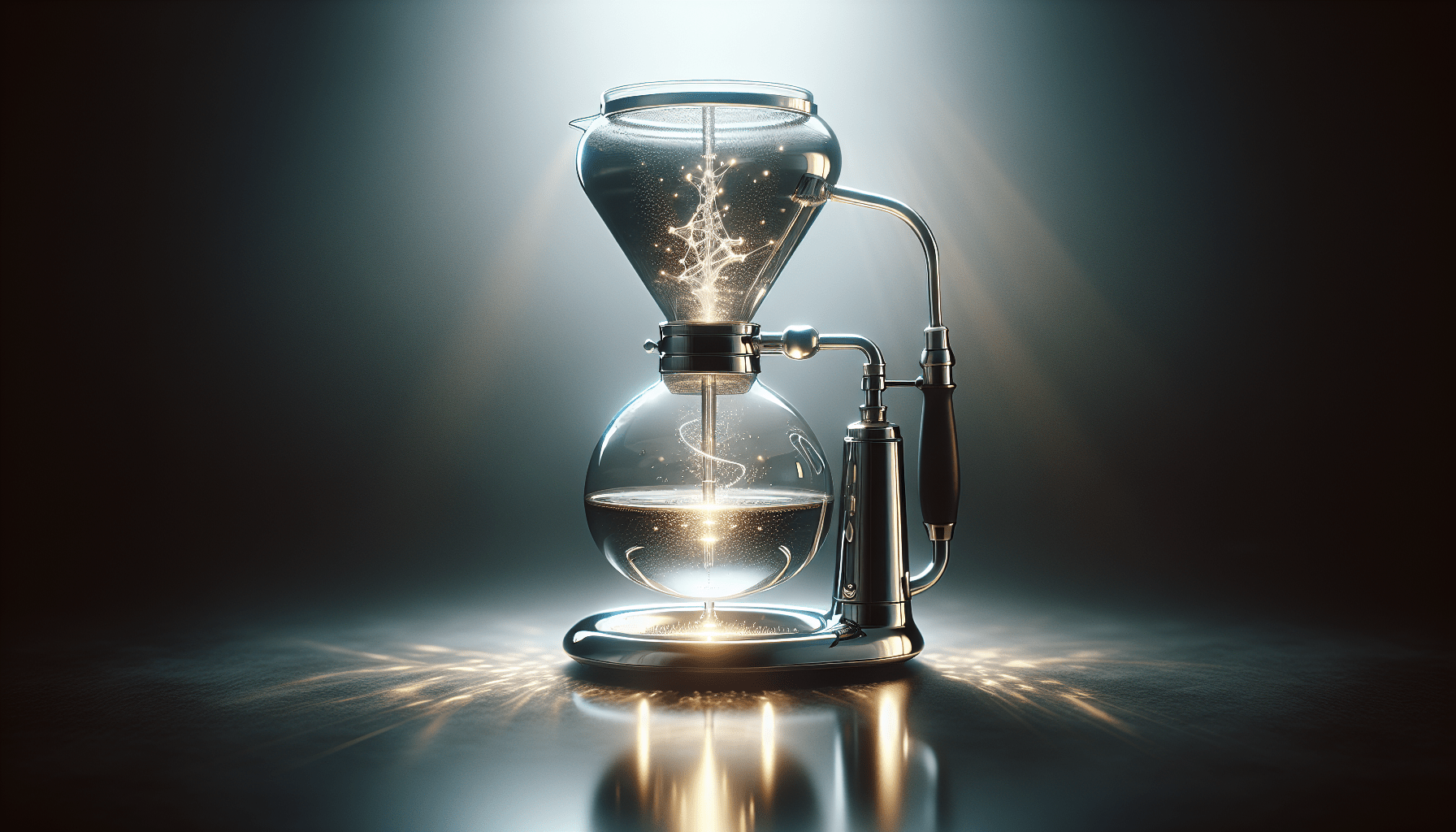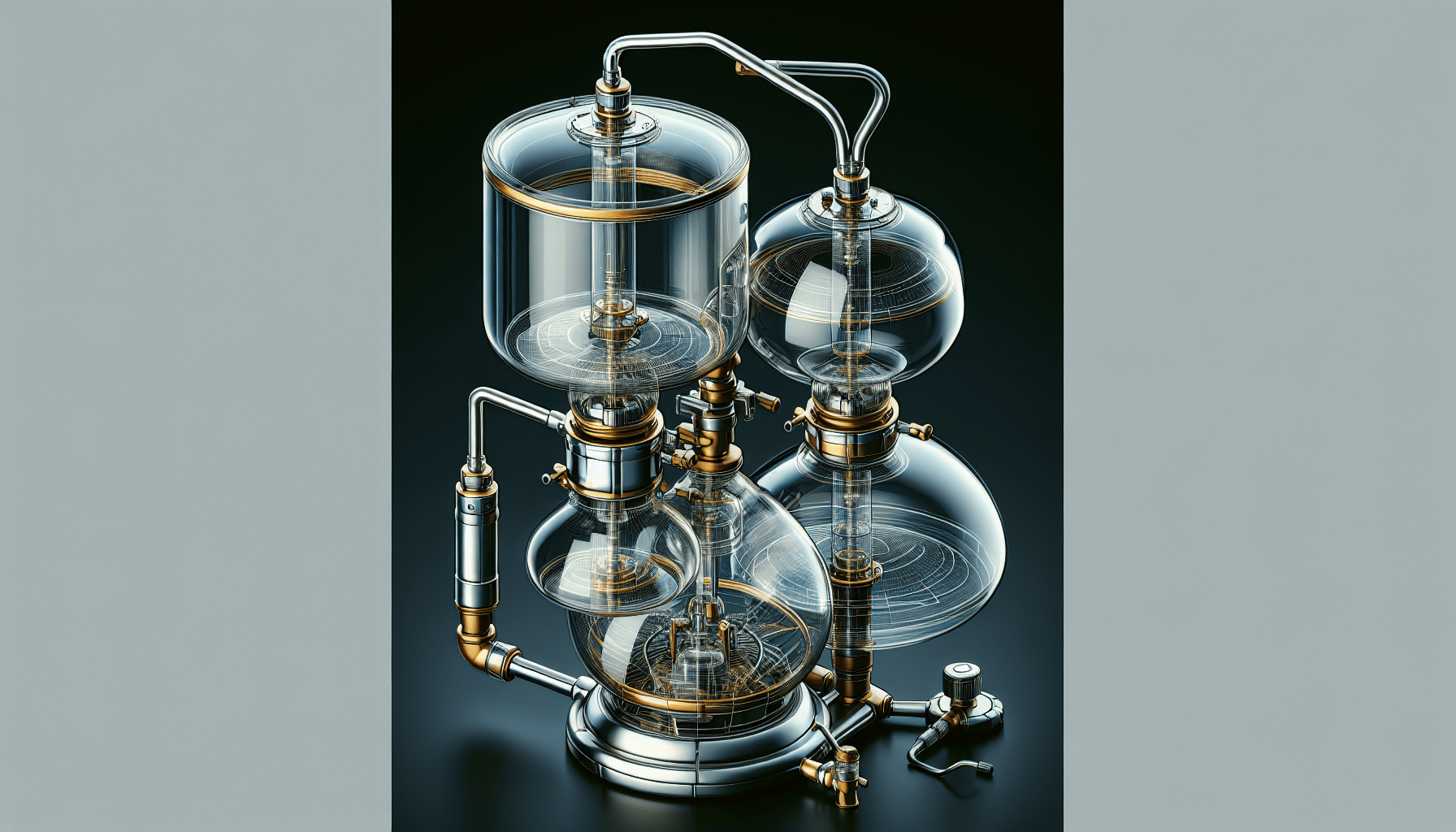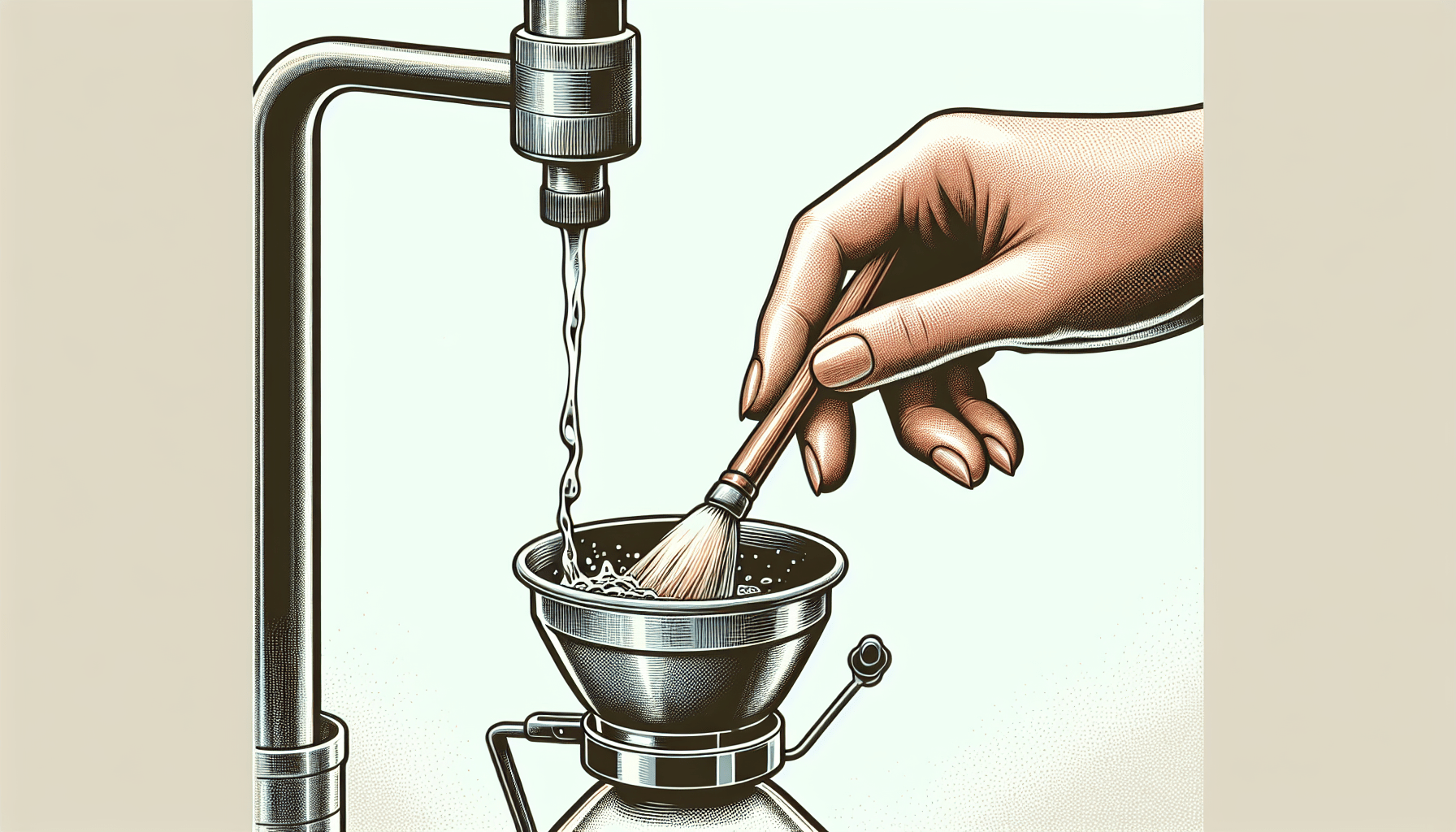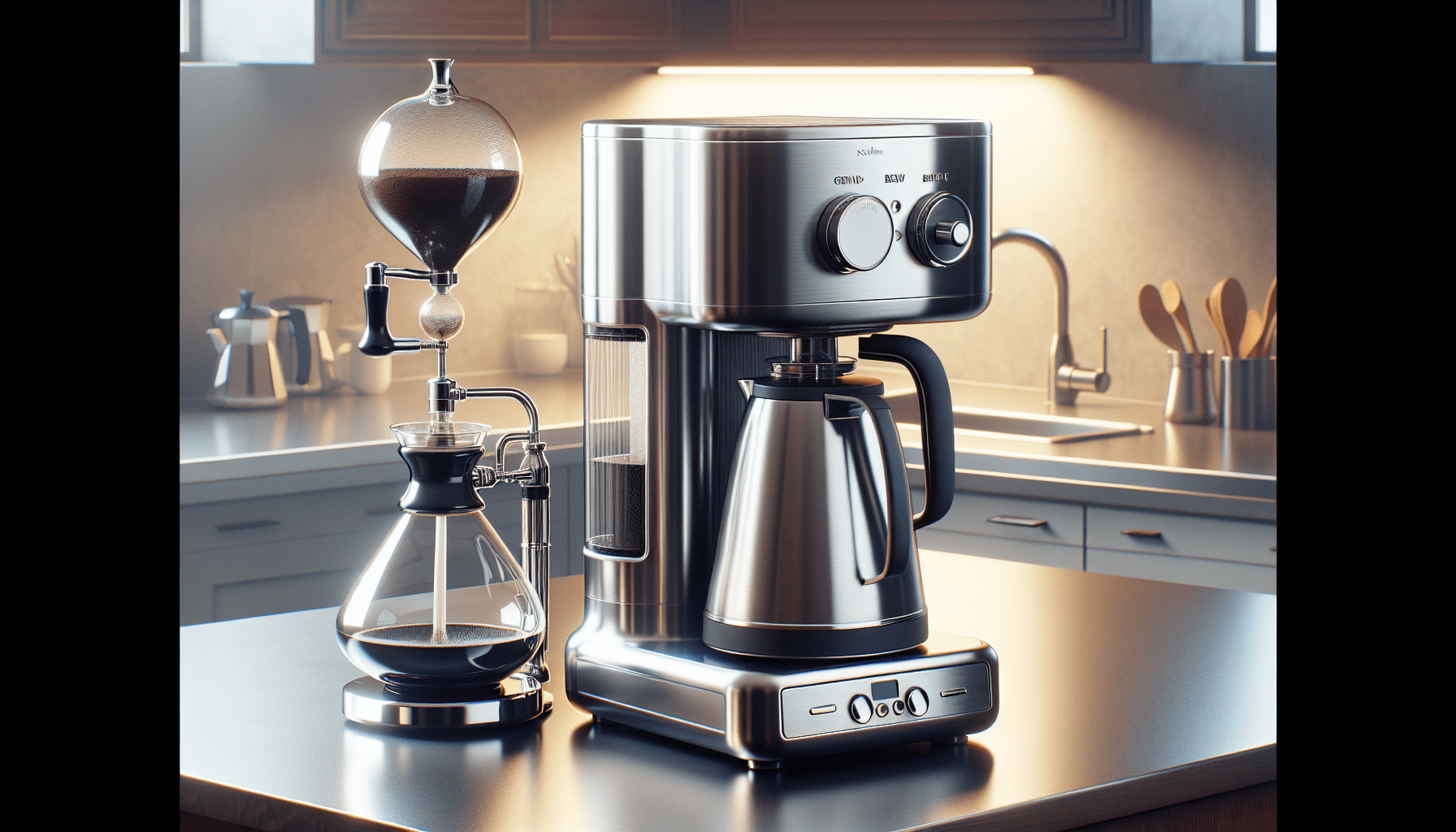You’re about to uncover the fascinating inner workings of a siphon coffee maker, the contraption responsible for brewing the most mesmerizing cups of java. With its elegant design and unique brewing process, this brewing device transports you into the realm of scientific coffee wizardry. Get ready to embark on a journey where vapor, heat, and gravity combine to bring forth a smooth, flavorful, and aromatic beverage. Discover the magic of siphon brewing and unlock the secrets behind this ingenious coffee maker.
Principles of Siphon Coffee Maker
Vacuum Brewing Method
The siphon coffee maker utilizes a vacuum brewing method to create a smooth and flavorful cup of coffee. This method involves two chambers, an upper and lower chamber, connected by a siphon tube. As the water heats in the lower chamber, it creates pressure, causing it to rise into the upper chamber where the coffee grounds are placed. Once the heat is removed, the brewed coffee is automatically filtered back down to the lower chamber, creating a vacuum and leaving behind any sediment or coffee grounds. This unique brewing process is not only visually appealing but also results in a clean and crisp coffee extraction.
Heat Source and Temperature
To brew coffee with a siphon coffee maker, a heat source such as a burner is used to heat the water in the lower chamber. The ideal temperature for brewing coffee in a siphon coffee maker is around 195-205°F (90-96°C). This range ensures proper extraction of the coffee’s flavors without scorching or over-extracting the beans. The burner or heat source should provide consistent and even heat to maintain the desired temperature throughout the brewing process.
Water and Coffee Grounds
The quality of the water used can greatly impact the taste of the coffee brewed in a siphon coffee maker. It is recommended to use filtered water or water with a neutral taste to avoid any unwanted flavors. Additionally, the ratio of coffee grounds to water is crucial in achieving the desired strength and flavor. A general guideline is to use 1 to 1.5 tablespoons of coffee grounds per 6 ounces of water. However, this ratio can be adjusted according to personal preference.
Pressure Differential
One of the key principles of the siphon coffee maker is the pressure differential created during the brewing process. As the water heats up and expands in the lower chamber, the pressure increases, forcing the water up the siphon tube and into the upper chamber where the coffee grounds are located. Once the heat is removed, the pressure in the lower chamber decreases, creating a vacuum effect that pulls the brewed coffee back down the siphon tube, filtering it as it returns to the lower chamber. This pressure differential ensures a clean and sediment-free cup of coffee.
Components of a Siphon Coffee Maker
Upper and Lower Chambers
A siphon coffee maker consists of two chambers: the upper chamber and the lower chamber. These chambers are usually made of glass or heat-resistant material. The upper chamber holds the coffee grounds and allows for the extraction process, while the lower chamber holds the water and creates the necessary pressure for brewing. The two chambers are connected by a siphon tube that allows the brewed coffee to flow back down to the lower chamber.
Siphon Tube
The siphon tube is a crucial component of a siphon coffee maker. It connects the upper and lower chambers, allowing the brewed coffee to be transported from the upper chamber back down to the lower chamber. The siphon tube is responsible for creating the pressure differential that drives the brewing process. It is important to ensure that the siphon tube is properly connected and free of any blockages to achieve optimal brewing results.
Filter
To ensure a clean and sediment-free cup of coffee, a filter is used in the siphon coffee maker. The filter is usually made of cloth, metal, or paper and is placed in the upper chamber to prevent any coffee grounds from entering the brewed coffee. It is important to choose a filter that fits securely in the upper chamber and provides adequate filtration without impacting the flavors and aromas of the coffee.
Burner or Heat Source
A burner or heat source is needed to heat the water in the lower chamber of the siphon coffee maker. The heat source can be a gas burner, an alcohol burner, or an electric stove. It is important to choose a heat source that provides consistent and even heat to maintain the desired brewing temperature. Some siphon coffee makers come with their own burner, while others require a separate heat source.
Vacuum Release Valve
Many siphon coffee makers are equipped with a vacuum release valve, also known as a safety valve. This valve allows the air pressure to be released gradually during the brewing process to prevent any sudden bursts or accidents. The vacuum release valve ensures a safe and controlled brewing experience, providing peace of mind to the user.
Step-by-Step Process of Brewing Coffee with a Siphon Coffee Maker
Assembling the Siphon Coffee Maker
Before brewing, it is important to assemble the siphon coffee maker properly. Start by placing the filter securely in the upper chamber. Make sure the siphon tube is correctly attached to both the upper and lower chambers. Ensure that all components are clean and free of any debris or residue.
Adding Water to the Lower Chamber
Once the siphon coffee maker is assembled, add the desired amount of water to the lower chamber. The amount of water will depend on the desired strength and number of cups of coffee. Be sure not to exceed the maximum fill line indicated on the coffee maker.
Adding Coffee Grounds to the Upper Chamber
Next, add the appropriate amount of coffee grounds to the upper chamber. The coffee grounds can be adjusted according to personal preference, but a general guideline is to use 1 to 1.5 tablespoons of coffee grounds per 6 ounces of water. Add the coffee grounds evenly in the upper chamber, ensuring that they are not packed too tightly.
Applying Heat to the Bottom Chamber
Once the coffee grounds are added, place the siphon coffee maker on the heat source, such as a burner or an electric stove. Apply heat to the bottom chamber to start the brewing process. It is important to use consistent and even heat to maintain the desired brewing temperature.
Water Transfer and Brewing
As the water in the lower chamber heats up, it will begin to rise through the siphon tube into the upper chamber. The hot water will extract the flavors and aromas from the coffee grounds, resulting in the brewing process. This step requires patience as the water slowly moves from the lower chamber to the upper chamber.
Brewing Time and Heat Adjustment
The brewing time can vary depending on personal preference and the desired strength of the coffee. On average, the brewing process takes approximately 1-3 minutes. It is important to monitor the heat and make adjustments to maintain the desired brewing temperature. If the coffee is brewing too quickly, reducing the heat can help extend the brewing time and extract more flavors.
Creating a Pressure Differential
After the brewing process is complete, it is time to create the pressure differential that will push the brewed coffee back down to the lower chamber. This is achieved by removing the heat source and allowing the lower chamber to cool down. As the temperature decreases, the pressure in the lower chamber also decreases, creating a vacuum effect.
Vacuum-Suction of Brewed Coffee
As the pressure decreases, the brewed coffee is automatically filtered through the siphon tube and back down to the lower chamber. This vacuum-suction process ensures a clean and sediment-free cup of coffee. It is important to let the coffee maker sit for a few moments to allow all the brewed coffee to transfer back down before proceeding to the next step.
Separating the Upper and Lower Chambers
With the brewed coffee now in the lower chamber, carefully separate the upper and lower chambers of the siphon coffee maker. Be cautious as the upper chamber may still be hot. This step allows for easy access to the brewed coffee and prepares the coffee maker for the next steps.
Filtering the Brewed Coffee
To ensure a sediment-free cup of coffee, it is important to filter the brewed coffee. Some siphon coffee makers have built-in filters in the lower chamber, while others require a separate filtering process. Use a separate mesh filter or a paper filter to strain the brewed coffee before serving. This step helps achieve clarity and enhances the flavors of the coffee.
Serving the Siphon Brewed Coffee
Once the brewed coffee is filtered, it is ready to be served. Pour the brewed coffee into cups or a carafe, depending on personal preference. Siphon brewed coffee is known for its smooth and clean flavors, so it is best enjoyed without any additives such as milk or sugar. Savor the distinct flavors and aromas that the siphon brewing method brings forth.
Advantages of Using a Siphon Coffee Maker
Aesthetic Appeal and Showmanship
One of the significant advantages of using a siphon coffee maker is its aesthetic appeal and showmanship. The visual process of the water rising and coffee brewing in the upper chamber creates a captivating experience for both the brewer and those around. The theatricality of the siphon brewing method adds an element of excitement to the coffee-making process.
Enhanced Flavors and Aromas
The siphon brewing method is known for producing a cup of coffee with enhanced flavors and aromas. The combination of the vacuum brewing method and the use of heat within a specific temperature range extracts the coffee’s natural oils and compounds, resulting in a clean and flavorful extraction. The use of a filter further enhances the clarity of the coffee, allowing the nuances of the beans to shine through.
Controlled Brewing Variables
Siphon coffee makers offer a high level of control over brewing variables such as water temperature, brewing time, and coffee-to-water ratio. By adjusting these variables, coffee enthusiasts can fine-tune their brewing process to suit their taste preferences. The ability to control these factors ensures consistent and repeatable results, resulting in a customized cup of coffee every time.
Medium to Full-Bodied Brews
Siphon brewed coffee tends to have a medium to full-bodied texture, offering a satisfying and robust mouthfeel. The vacuum brewing process extracts a higher concentration of coffee solids, resulting in a more substantial brew compared to other brewing methods. This characteristic makes siphon coffee particularly enjoyable for those who prefer a rich and full-bodied cup.
Easy Cleanup
Despite the intricate brewing process, siphon coffee makers are surprisingly easy to clean. The separate chambers and removable filter make it convenient to rinse and wash each component thoroughly. Ensuring proper cleaning and maintenance will prolong the lifespan of the siphon coffee maker and maintain its brewing performance.
Factors Affecting Siphon Coffee Brewing
Grind Size and Consistency
The grind size and consistency of the coffee grounds play a crucial role in siphon coffee brewing. For siphon brewing, a medium-fine grind is generally recommended. A coarser grind may result in a weak and under-extracted coffee, while a finer grind can lead to over-extraction and a bitter taste. Consistency is also key to ensure even extraction and prevent uneven brewing.
Coffee to Water Ratio
The ratio of coffee grounds to water greatly affects the strength and flavor of the brewed coffee. As a general guideline, a coffee-to-water ratio of 1 to 1.5 tablespoons per 6 ounces of water is a good starting point. However, personal preference and the desired strength of the coffee may require adjusting the ratio. Experimentation and taste testing can help determine the ideal coffee-to-water ratio for individual preferences.
Water Temperature
Water temperature is a critical factor in siphon coffee brewing. The ideal range for brewing coffee in a siphon coffee maker is around 195-205°F (90-96°C). Water that is too hot can scorch the coffee grounds and over-extract the flavors, resulting in a bitter taste. Conversely, water that is too cold may under-extract the coffee and produce a weak brew. Ensuring the proper water temperature is crucial to achieving the desired flavors and aromas.
Brew Time
The brew time, or the duration of the brewing process, can impact the strength and flavors of the coffee. The average brew time for siphon coffee is around 1-3 minutes, depending on personal preference. Adjusting the brew time can affect the extraction rate of the coffee grounds, resulting in variations in strength and flavor. Monitoring and experimenting with brew times can help achieve the desired taste profile.
Filter Material
The choice of filter material can affect the taste and clarity of the brewed coffee. Common filter materials for siphon coffee makers include cloth, metal, and paper. Each material offers different levels of filtration and can impact the flavors and oils extracted from the coffee grounds. Experimenting with different filter materials can help determine the preferred balance between flavor clarity and sediment-free coffee.
Tips for Better Siphon Coffee Brewing
Use Freshly Roasted Coffee Beans
For the best flavor and aroma, it is recommended to use freshly roasted coffee beans. Beans that are roasted within two to three weeks provide the most vibrant and complex flavors. Look for reputable local coffee roasters or online sources that offer freshly roasted beans to enhance the overall coffee brewing experience.
Experiment with Different Coffee Origins and Roasts
Siphon coffee brewing allows for the exploration of different coffee origins and roasts. Each coffee origin and roast profile offers unique characteristics and flavor notes. Experimenting with various coffee beans can expand the palate and provide an exciting variety of brewing experiences. Take the opportunity to explore different regions and roasts to find personal favorites.
Grind Coffee Immediately Before Brewing
To maximize the flavors and aromas of the coffee, it is recommended to grind the coffee beans immediately before brewing. Grinding the coffee too far in advance can result in flavor loss due to exposure to oxygen. Investing in a reliable grinder and grinding the beans just before brewing ensures a fresh and flavorful cup of coffee.
Preheat All Components
Preheating all the components of the siphon coffee maker is essential for maintaining the desired brewing temperature. Before assembling the coffee maker, rinse all the components with hot water to warm them up. This step helps prevent heat loss during the brewing process and ensures a consistent and optimal extraction.
Maintain Consistent Heat Source
To achieve consistent and even heat, it is important to maintain a constant heat source throughout the brewing process. Whether using a gas burner, alcohol burner, or electric stove, choose a heat source that can maintain a steady temperature. Avoid abrupt changes in temperature that could impact the brewing process and flavor extraction.
Observe Brewing Time and Adjust Accordingly
As mentioned earlier, the brew time can greatly impact the strength and flavors of the coffee. It is important to observe the brewing time and make adjustments accordingly. If the coffee is brewing too quickly, reducing the heat or adjusting the coffee-to-water ratio can help extend the brew time and enhance the flavors. Conversely, if the brew time is too long, increasing the heat or adjusting the grind size may be necessary.
Clean the Siphon Coffee Maker Regularly
To ensure the longevity and optimal performance of the siphon coffee maker, regular cleaning is essential. After each use, disassemble the coffee maker and clean each component thoroughly. Remove any residual coffee grounds or oils that may affect the taste of future brews. Pay special attention to the filter and siphon tube, ensuring they are free from any blockages or buildup.
Common Mistakes and Troubleshooting
Uneven Grind Size
One common mistake in siphon coffee brewing is using an uneven grind size. An inconsistent grind will result in uneven extraction and an imbalanced taste profile. Ensure that the coffee grounds are evenly and consistently ground to achieve a uniform brew.
Incorrect Coffee to Water Ratio
Using an incorrect coffee-to-water ratio can greatly affect the strength and flavor of the brewed coffee. Using too little coffee grounds can result in a weak and under-extracted brew, while using too much can make the coffee overly strong and bitter. Experiment with different ratios to find the ideal balance for personal taste preferences.
Inconsistent Water Temperature
Maintaining a consistent water temperature throughout the brewing process is essential for proper extraction. Fluctuations in water temperature can lead to inconsistent flavors and weak or over-extracted coffee. Monitor the heat source and make adjustments as needed to maintain the desired brewing temperature.
Improper Brewing Time
The brewing time should be observed and adjusted as necessary to achieve the desired strength and flavor. Brewing the coffee for too long can result in over-extraction and bitterness, while brewing for too short of a time may produce a weak and under-extracted brew. Experiment and find the optimal brew time for personal preferences.
Leaks or Blockages
Leaks or blockages can occur if the siphon coffee maker is not assembled or disassembled correctly. Ensure all the components fit securely and the siphon tube is properly connected. If leaks or blockages occur during brewing, carefully inspect the components for any issues and make the necessary adjustments.
Coffee Grounds in Brew
If coffee grounds are present in the brewed coffee, it may be due to issues with the filter or the grind size. Ensure that the filter fits securely in the upper chamber and provides adequate filtration. Additionally, check the grind size to ensure it is suitable for siphon coffee brewing. Adjustments may need to be made to achieve a sediment-free cup of coffee.
Comparison with Other Brewing Methods
Differences from Drip Coffee Makers
Siphon coffee makers differ from drip coffee makers in several ways. Drip coffee makers use gravity to extract the coffee, while siphon coffee makers utilize a vacuum brewing method. The siphon brewing method allows for a more thorough extraction and produces a cleaner and more nuanced cup of coffee. Additionally, the visual experience and showmanship of siphon brewing set it apart from the simplicity of drip coffee makers.
Contrasts with French Press
French press brewing and siphon brewing both offer full-bodied coffee with robust flavors. However, the processes and results vary. French press brewing involves steeping coffee grounds directly in hot water, while siphon brewing uses a vacuum brewing method. Siphon brewing tends to produce a cleaner and sediment-free cup of coffee, while French press brewing can have more body and oily characteristics.
Compared to Pour Over
Pour over brewing is known for its simplicity and control over brewing variables. Both pour over and siphon brewing allow for customization and precise adjustments of coffee-to-water ratio and brewing time. However, siphon brewing offers a unique visual experience and a distinct full-bodied flavor profile, while pour over brewing tends to produce a lighter and cleaner cup of coffee.
Distinctive from Espresso
Espresso brewing differs greatly from siphon coffee brewing. Espresso is created by forcing hot water through finely ground coffee under high pressure. The result is a concentrated and intense flavored shot of coffee. Siphon brewing, on the other hand, involves a gentler extraction process that showcases the flavors and aromas of the coffee in a medium to full-bodied cup. The brewing methods and equipment used for espresso and siphon coffee are also different.
Popular Siphon Coffee Maker Brands
Hario
Hario is a well-known brand in the specialty coffee industry, offering a range of high-quality siphon coffee makers. The Hario Technica and Hario Next are popular models known for their durability and consistent brewing performance. Hario siphon coffee makers are often praised for their sleek design and attention to detail.
Yama
Yama is another reputable brand specializing in siphon coffee makers. Yama offers various models, including the Yama Glass Stovetop Siphon and the Yama Tabletop Siphon. Known for their craftsmanship and elegant design, Yama siphon coffee makers are favored by coffee enthusiasts for their brewing precision and exceptional results.
Bodum
Bodum, a well-established brand in the coffee industry, also offers siphon coffee makers. The Bodum PEBO Vacuum Coffee Maker is a popular model known for its sleek design and user-friendly features. Bodum siphon coffee makers are appreciated for their reliability and solid performance.
KitchenAid
Known for its kitchen appliances, KitchenAid also offers a siphon coffee maker that combines functionality with style. The KitchenAid Siphon Coffee Brewer is praised for its intuitive controls and consistent brewing capabilities. KitchenAid siphon coffee makers are revered for their quality construction and reliable results.
Nispira
Nispira is a brand that focuses on providing affordable and accessible siphon coffee makers. The Nispira Luxury Belgian Siphon Coffee Maker is a popular model known for its simplicity and value for money. Nispira siphon coffee makers are a preferred choice for those new to siphon brewing or looking for budget-friendly options.
Conclusion
Siphon coffee makers offer a unique and captivating brewing experience, producing flavorful and aromatic cups of coffee. The vacuum brewing method, combined with precise control over brewing variables, allows coffee enthusiasts to tailor their brewing process to their liking. With proper technique, attention to detail, and the right choice of coffee beans, siphon coffee brewing can elevate the coffee experience to new heights. So why not try brewing a cup of siphon coffee and indulge in the rich flavors and mesmerizing showmanship that this brewing method brings?




